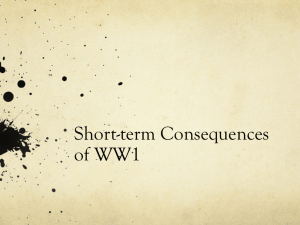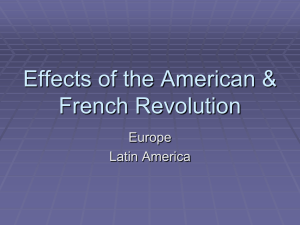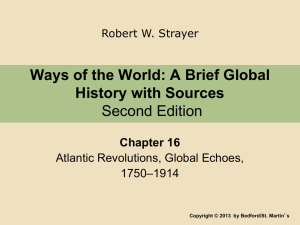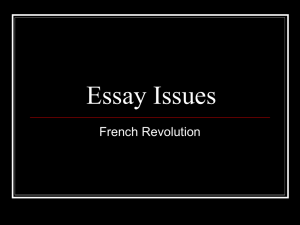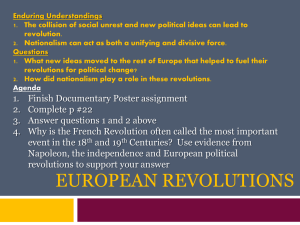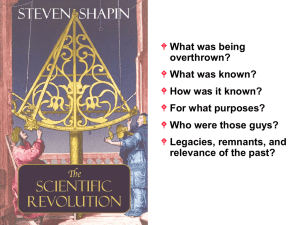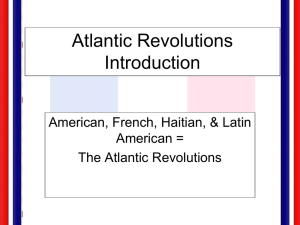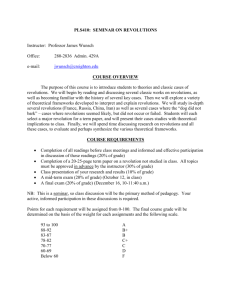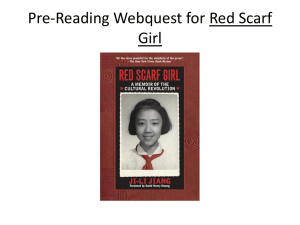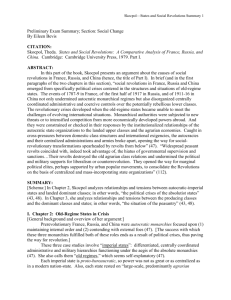Week 3 - Lit Review
advertisement
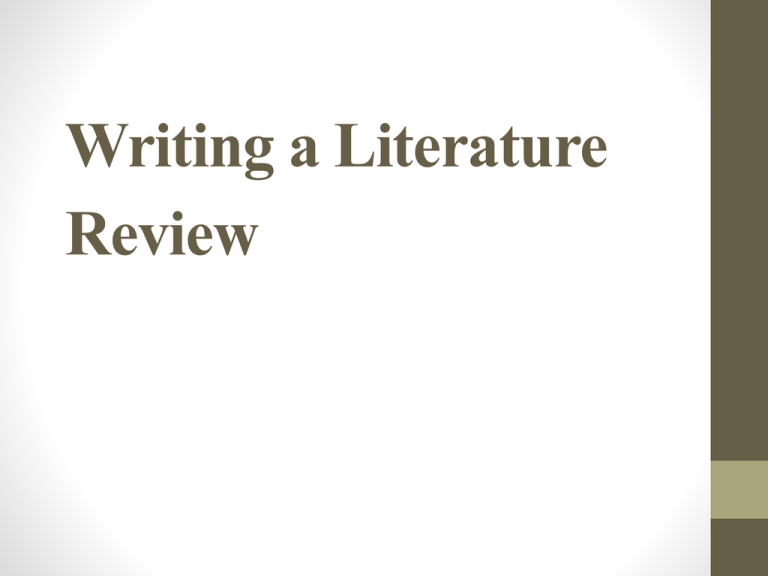
Writing a Literature Review Overview • What is a literature review? • Questions that a literature review should answer • Selecting Articles to Review • Structure of a Literature Review • Useful phrases and Sentences for academic writing What is a literature review? A literature review is a summary and critical analysis of writings by scholars on a particular topic/theme. A literature review, however, does not simply reproduce/summarise the literature; it is both descriptive and analytical. What is a literature review? DESCRIPTIVE • Discuss the most widely accepted findings on the topic. • State the most widely accepted definitions of concepts, hypotheses etc. in relation to your topic. • Identify the methods used to make and support the findings in the literature. • Establish the most recent authoritative theory on the subject. What is a literature review? ANALYTICAL • The integration of ideas from different sources, highlighting differences and similarities. • Showing the relevance of the literature to your research topic. (how it supports & is contradictory to your main hypothesis) • Illustrate which arguments are most important/ pertinent in the field of study – using examples/primary sources to do so. Questions that a LR should answer • The following should be answered by a literature review: • 1. What do we already know in the immediate area concerned? • 2. What are the characteristics of the key concepts or the main factors or • variables? • 3. What are the relationships between these key concepts, factors or • variables? • 4. What are the complementary existing theories/approaches? Selecting Articles to Review The aim is not to discuss every single article, but the major opinions/themes on the topic. The main articles you should aim to use in your review are the ‘seminal’ articles, referenced by most authors in the particular field/topic you are researching. Selecting Articles to Review It is difficult to discuss the following topics without these authors: • Post-colonial state: Crawford Young • Elections and voting systems: Arend Lijphart • Nationalism: Gellner • Democracy: Huntington Finding Sources: The UCT library website has a link to a database (ISI Citation Database) which can find all other articles which have cited a particular article. - Go to ‘cited reference search’ - Type the author’s last name, the journal & year in which the article appeared in the appropriate boxes - This will give you a list of authors and articles which have followed or disagreed with the author. Google Scholar (‘Cited by’ link) and the Academic Search Premier on the UCT library website (‘cited references’ link) have similar functions. Structure of a Literature Review Introduction Example The Neopatrimonial School refers to literature that attributes Africa’s poor political and economic record to Neopatrimonialism, which is said to have weakened the state’s capability to foster development and economic growth. Increasingly arguments have emerged which challenge this view on the basis of the very utility of the concept as an explanatory tool in Africa. The main argument is that neopatrimonialism merely describes the style of governance in a country, but does not indicate the type of strategies or policies a state will pursue and with what success. This paper aims to review these two contrasting sets of literature in order to illustrate that Neopatrimonialism does not necessarily lead to underdevelopment. The review first highlights the main arguments of the neopatrimonial school and critiques these arguments by reflecting on the contrasting emerging literature. Structure of a Literature Review Introduction Example Revolutions: Types, Causes and Theories The increased revolutionary activity in the twentieth century led to a growth and development in the study and theories of revolutions. The origins of the modern study of revolutions can be traced back to Alexis de Tocqueville who analysed the causes and effects of the French Revolution and, more influentially, the theories of Karl Marx in the nineteenth century (Foran, 2005:5). In the twentieth century, social scientists drew on these theories as well as the examples of revolutions occurring around them to form their own revolutionary theories or revise and improve existing ones. The twentieth century theorists can be divided into two generations. The first generation of the 1920sand1930s theorised on the Natural History of Revolutions which offers a descriptive account of what happens during a revolution as can be seen in the works of L. P. Edwards (Foran, 2005:8).The second generation from the 1960s is more focused on identifying the causes of revolutions (Foran, 2005:9). These theoristsbranch out into the Aggregate Psychological, Political-Conflict, and Structural approaches. The leading theorists of these respective approaches are James Davies, Charles Tilly, and ThedaSkocpol (Skocpol, 1979:9). Revolutionary theories are concerned with both their causes and effects. The effect of a revolution defines its type, while its causes determine the theory used to analyse it (Goldstone, 2009:213). The following literature review will, firstly, look at the different types of revolutions with special reference to social revolutions. It will then analyse the different theories used to identify the causes by contrasting and critiquing the different approaches. I will conclude that all theories contain components that can be applicable when studying revolutions and the theories often complement each other. Although the structural approach is fundamentally different from the “purposive” approaches, it is not without faults and cannot be used by itself to analyse a revolution Structure of a Literature Review Introduction Example Social Revolutions “The Communists disdain to conceal their views and aims. They openly declare that their ends can be attained only by the forcible overthrow of all existing social conditions. Let the ruling classes tremble at a communist revolution. The proletarians have nothing to lose but their chains. They have a world to win. Workingmen of all countries, unite” (Marx & Engels : 268) In this well know and insightful call to arms Marx and Engels finish the work that pioneered the study of revolution, as well as created a whole new discourse about the nature and ordering of society: the Communist Manifesto. This essay shall in its own small way continue in the shadow of these great thinkers as it seeks to plot an evolution of the body of work on social revolutions, framing this in the broader context of the discussion on revolutions more generally. It shall give a brief overview of the work on revolution sighting such important thinkers as Marx & Engels and de Tocqueville. It shall then shift focus towards, and provide an overview of the work on social revolutions specifically (defined later) here the important work of Skocpol, Davies, Goldstone, Huntington and Tilly, will be focused on. We shall seek to frame the debate, critique and discuss the conversation on social revolutions, and to provide a direction for future research. Structure of a Literature Review Chronological Developmental States in Africa i) 1964-1989: the authoritarian advantage: the success of the East Asian Tigers. ii) 1990- date: democracy is crucial to development: democratic developmental states. Structure of a Literature Review Thematic ‘Why do Authoritarian Regimes often endure?’ Literature on this topic cites the following main themes: • i) Coercive Apparatus • ii) Strength of State • iii) International Support Networks Structure of a Literature Review Methodological Conceptualising Revolutions •Davies’ J-Curve vs Skocpol’s characterization of revolutions as rapid, fundamental change of socioeconomic and political institutions and large-scale class upheaval. Useful phrases and Sentences for academic writing Referring to another authors ideas • Huntington put forward the idea that…. • In Young’s view…… • According to Davies’ perspective……. • Goldstone argues that…. Providing support • Tilly’s findings (1973) support this idea. • For example in 1984… • This shows that…. Useful phrases and Sentences for academic writing Making a concession • Bellin’s study provides much relevant information. • Skocpol makes several interesting points… • Chandra argues convincingly Showing Disagreement • There are several flaws in Przeworski’s argument. • While the discussion makes some good points, there are serious problems. • Taylor’s argument cannot be accepted for several reasons. Useful phrases and Sentences for academic writing Comparing • Whereas Molomo argues for……….., Samatar presents a case against it. • Botswana is considered to have a good democracy, however…. Weakening a statement • Milan’s argument is not completely valid because…. • This is possibly a result of…….as a result of… Main Tips - Summarise the articles with as much detail as each article merits. - Identify consistent patterns and points of agreement & inconsistencies, disagreement & unresolved issues across these texts to establish what is known. - Read widely but make sure to only use the most significant and relevant sources of information to date. - Each paragraph should have a topic sentence and a clear main idea. - Pay attention to the vocabulary you use to aid in your overall analysis. Conclusion - Summary of what you have drawn from the literature: e.g. major methodological flaws, gaps in the research, inconsistencies in the findings and therefore areas that are pertinent to future study of the topic. - Where might the discussion proceed; identify the gap your work will fill/ if your purpose was simply to identify the gaps in the literature, discuss the importance of filling these gaps. - Remember to: maintain the focus established in your Introduction.
